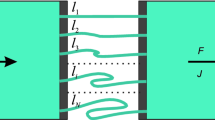Abstract
Using plausible assumptions a description of the distribution of externally added low molecular weight solutes in individual subcellular regions of biosystems is reduced to a compartmental system of specific structure having, in general, only numerical solutions. Frequently occurring application of biologically active substances in low doses, however, elicits the conditions (i.e. undirectional membrane transport involving accumulation, instantaneous and linear binding to macromolecules and metabolism obeying first order kinetics) that enable one to solve the system explicitly. Equations have been derived, describing the time course of drug concentration in any subcellular phase of arbitrary biosystem having membranes of similar composition, including tissues with a cellular structure (degenerate case). Accuracy of the description is tested on the relationship between physicochemical and biological properties of drugs, bioactivity being used to monitor the concentration in the receptor region.
Similar content being viewed by others
Literature
Aarons, L., D. Bell, R. Waigh and Q. Ye. 1982. “Parabolic Structure-Activity Relationships: A Simple Pharmacokinetic Model.”J. Pharm. Pharmacol. 34, 746–749.
Atkins, G. L. 1969.Multicompartment Models for Biological Systems. London: Methuen.
Baláž, Š., A. Kuchár, J. Dřevojánek, J. Adamcová and A. Vrbanová. 1988b. “Liposome/Saline Partition Coefficients of Low Molecular Weight Solutes by Gel Chromatography.”J. biochem. biophys. Meth. (in press).
— and E. Šturdík, 1984. “Passive Transport and Lipophilicity. Closed Model of Drug Distribution.” InQSAR in Design of Bioactive Compounds. M. Kuchař (Ed.). Barcelona: Prous.
— and —. 1985. “Lipophilicity and Drug Disposition.” InQSAR in Toxicology and Xenobiochemistry. M. Tichý (Ed.), Amsterdam: Elsevier.
—— and —. 1986. “Kinetics of Unidirectional Transport in Multimembrane Systems as Influenced by Binding to Macromolecules.”Biophys. Chem. 24, 135–142.
—— and —. 1987. “Kinetics of Non-equilibrium Metabolism-coupled Passive Transport in Biosystems.”Gen. Physiol. Biophys. 6, 65–77.
——, I. Dibus, L. Ebringer, L. Štibrányi and M. Rosenberg. 1985b. “Quantitative Relationships between Lipophilicity and Mutagenic Effects of N-Substituted Amides of 3-(5-Nitro-2-Furyl)-Acrylic Acid onSalmonella typhimurium.”Chem.-biol. Interact 55, 93–108.
——, M. Hrmová, M. Breza and T. Liptaj 1984a. “Kinetics of Drug Partitioning in Closed 4-Compartment Systems and its Application to QSAR.”Eur. J. med. Chem. 19, 167–171.
—— M. Rosenberg, J. Augustín and B. Škárka. 1988a. “Kinetics of Drug Activities as Influenced by their Physicochemical Properties: Antibacterial Effects of Alkylating 2-Furylethylenes.”J. theor. Biol.,125, 115–134.
—— and B. Škárka 1984b. “Mathematical Description of Nonequilibrium Passive Transport in Biosystems.”Collect. Czechoslov. chem. Commun. 49, 1382–1389.
—— and M. Tichý. 1985a. “Hansch Approach and Kinetics of Drug Activities.”Quant. Struct.-Act. Relat. 4, 77–81.
Benson, S. W. 1960.The Foundations of Chemical Kinetics. New York: McGraw-Hill.
Collander, R. 1951. “The Partition of Organic Compounds between Higher Alcohols and Water.”Acta chem. scand. 5, 774–780.
Cooper, E. R., B. Berner and R. C. Bruce, 1981. “Kinetic Analysis of Relationship between Partition Coefficient and Biological Response.”J. pharm. Sci. 70, 57–59.
Dearden, J. C. and M. S. Townend. 1978. “Digital Computer Simulation of the Drug Transport Process.” InQuantitative Structure-Activity Analysis, R. Franke and P. Oehme (Eds). Berlin: Akademie-Verlag.
Eigen, M. 1968 “Kinetics of Reaction Control and Information Transfer in Enzymes and Nucleic Acids.” InNobel Symposium on Fast Reactions and Primary Processes in Chemical Kinetics, S. Claesson (Ed.). Stockholm: Almquist and Wiksell.
Fletcher, R. and M. J. D. Powell. 1963. “A Rapidly Convergent Descent Method for Minimization.”Comput. J. 6, 163–168.
Hansch, C. and J. M. Clayton. 1973. “Lipophilic Character and Biological Activity of Drugs. II—The Parabolic Case.”J. pharm. Sci. 62, 1–21.
— and W. J. Dunn III. 1972. “Linear Relationships between Lipophilic Character and Biological Activity of Drugs.”J. pharm. Sci. 61, 1–18.
Jacquez, J. A. 1972.Compartmental Analysis in Biology and Medicine. Amsterdam: Elsevier.
Kramer, C. R., L. Beck and H. Arndt. 1982. “Quantitative Struktur-Aktivitäts-Beziehungen für die Wachstumshemmung vonChlorella vulgaris-Suspensionen durch 4-Alkylsemicarbazide.”Biochem. Physiol. Pflanzen 177, 192–196.
Kubinyi, H. 1979. “Lipophilicity and Biological Activity. Drug Transport and Drug Distribution in Model Systems and in Biological Systems.”Arzneim.-Forsch. 29, 1067–1080.
Penniston, J. T., L. Beckett, O. L. Bentley and C. Hansch. 1969. “Passive Permeation of Organic Compounds through Biological tissue: a Non-steady-state Theory.”Mol. Pharmacol. 5, 333–341.
Rescigno, A. and G. Segre. 1966.Drug and Tracer Kinetics. Waltham: Blaisdell.
Wagner, J. G. 1975.Fundamentals of Clinical Pharmacokinetics. Hamilton: Hamilton Press.
Wolf, M. G., G. Heinzel, F. W. Koss and G. Bozler. 1977. “Modellentwicklung in der Pharmokokinetik. II. Verallgemeinerte Theoretische Darstellung der Vollständigen Integration Linearer Kompartmentmodelle Beliebiger Struktur.”Arzneim-Forsch 27, 900–904.
Zwolinski, B. J., H. Eyring and C. E. Reese. 1949. “Diffusion and Membrane Permeability.”J. phys. Colloid Chem. 53, 1436–1453.
Author information
Authors and Affiliations
Rights and permissions
About this article
Cite this article
Baláž, Š., Šturdík, E. & Augustín, J. Subcellular distribution of compounds in biosystems. Bltn Mathcal Biology 50, 367–378 (1988). https://doi.org/10.1007/BF02459706
Received:
Revised:
Issue Date:
DOI: https://doi.org/10.1007/BF02459706




